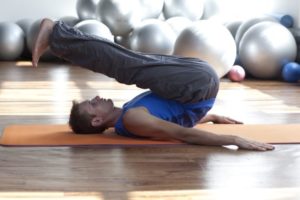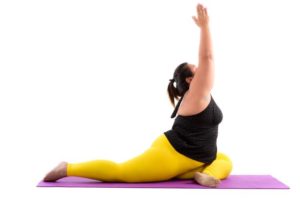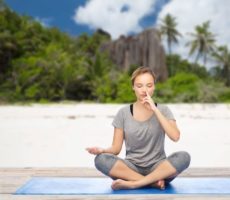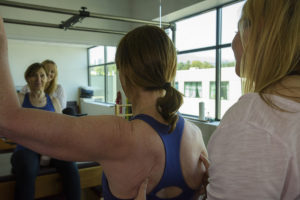Yoga vs. Pilates
When time is short and the pressure to find the most effective fitness program is high, I’m often asked, “what’s better, yoga or Pilates?” For the most part, I think that the more you move, the better. But it’s good to research what might be the best fit for you. The answer to the Yoga vs. Pilates dilemma really depends on who you are, what you need, and what your goals are. To help you make an informed choice, let’s have a look at some of the most important elements of both Yoga and Pilates.
(Full disclosure: I have been a practicing Pilates professional for the past 25 years. My observations about yoga in this post are based on my own personal explorations and experience, not on any professional yoga training.)
Yoga Origins
Yoga has its origins in India several thousand years ago, developed to promote mental, physical and spiritual balance. The yoga “asanas” – the physical part most westerners understand to be yoga – are typically practiced on a mat; either in a class with an instructor or alone. In it’s fullest form, yoga incorporates balanced movement, meditation, relaxation and diet. Yoga is a way of life and a discipline, and the fitness world has fallen in love with it. There are now almost endless ways to practice it, depending on what you’re drawn to.
Pilates Origins
The Pilates method was developed in the early part of the 20th century by Joseph H. Pilates for health and rehabilitation. Held in an internment camp during the First World War, Pilates trained other internees his methods to keep them healthy and moving. In the 1920’s he moved to the USA and began teaching his technique to dancers and performers. They loved how well his training helped them survive the demands of their professions, and helped them rehabilitate from injury. Today, Pilates has grown into a worldwide fitness phenomenon, adopted by athletes and dancers, fitness fans and rehab professionals.
The Why of Yoga & Pilates: Core Principles
A comprehensive yoga practice encourages clean, compassionate living on every level. The purpose of a yoga practice, according to the International Sivananda Yoga Vedanta Centres is to “reunite the individual soul with the Absolute or pure consciousness.” The ancient teachings of yoga can be organized into five basic principles. These are: proper exercise (asana), proper breathing (pranayama), proper relaxation (savasan), proper diet (vegetarian) and positive thinking (vedanta) and meditation. With regular practice, these five principles can contribute to more optimal physical and mental health, as well as spiritual growth.
The Pilates method has six core principles of its own: concentration, control, centering, precision, breath and fluid movement. Joseph Pilates believed that people need to focus to understand, control and integrate movement for for optimal health. The Pilates method is about fluid, whole body movement with support from the body’s core. The exercises demand precision; with the idea that a well organized and controlled body moves fluidly and efficiently. Good breathing is the inspiration for it all; as a key part of core function and a connection to the whole body in motion. (You can read more about the principles of Pilates in my 2015 blog post: “Contrology in the 21st Century: Is Pilates Still Relevant?”)
When you look at their core principles, you’ll find some similarities between yoga and Pilates. But they are not interchangeable. The biggest difference between them is that yoga incorporates a spiritual component that that Pilates does not. There are many who would argue that in its purest form, yoga isn’t a fitness modality at all. It’s a way of life. Yoga involves a conscious attention to and practice of many different facets of healthy living; with spirituality and meditation playing a central role. The primary purpose of Pilates is fitness, not spiritual growth.
Yoga and Pilates for Fitness
Before we dive in to whether yoga or Pilates is better for fitness, let’s first ask ourselves… fitness for what? If you’re looking to torch calories and lose a bunch of weight, neither Pilates or Yoga is your best choice. The more advanced and athletic forms of both will burn calories, but realistically, you won’t shed epic pounds. For the most part, what you eat determines your size, and how you move creates your shape. Both yoga and Pilates will change your shape; leading to a longer, more balanced musculature, and more ease in motion. But neither one is likely to lead to massive weight loss.
What changes are you seeking in your quest for better fitness? Are you looking for more core stability and strength? Are you looking to increase mobility or flexibilty? Do you want more overall muscle tone? Do you want to improve the quality and efficiency of your motor patterning for more ease in movement? These are all questions to think about as you make your choice. Here are some thoughts on how Pilates and yoga can contribute to overall fitness:
 Core Stability & Strength:
Core Stability & Strength:
Both Pilates and yoga incorporate movements that involve the body’s core (abdominals, pelvic floor, back muscles and respiratory diaphragm). However, most Pilates programs focus specifically on teaching access, training for tone and integration of the core into whole body movement. (Please note – core work is about more than just strong, flat abdominal muscles!! More on that here.) Pilates may offer a more direct route to core stability and strength.
Muscle Tone:
Pilates fitness classes focus on activation of muscles in the context of larger, whole body movement. Toning muscle in the body is a fundamental part of the plan. Yoga will develop muscle tone, but stick to the more athletic forms if deliberate toning is your goal. Yoga and Pilates both tend to build long, lean muscles. If you want to create muscle bulk you’d be better off lifting weights at the gym.
Mobility and Flexibility:
First, remember that these terms mean very different things. Mobility is the ability of your body’s joints to move with stable and balanced ease through a full range of motion. Flexibility refers to the ability of the muscles to lengthen and stretch. Both yoga and Pilates work to balance the muscles. But in my opinion, if you’re looking for pure flexibility – yoga wins hands down. If you’re looking for better overall joint mobility, Pilates comes out ahead.
 You’ll often find lots of stretchy bendy types in a yoga class. Don’t be scared off! Folks who tend to be tight in the hips, back and shoulders can really benefit from the stretch available in a yoga class. It may feel tough at first. Be gentle with yourself though, and you’ll likely find some lovely new length in your system. (A wonderful yoga teacher once whispered in my ear: “effort is one thing, but struggle is optional.” Give yourself permission to find some ease and flow.)
You’ll often find lots of stretchy bendy types in a yoga class. Don’t be scared off! Folks who tend to be tight in the hips, back and shoulders can really benefit from the stretch available in a yoga class. It may feel tough at first. Be gentle with yourself though, and you’ll likely find some lovely new length in your system. (A wonderful yoga teacher once whispered in my ear: “effort is one thing, but struggle is optional.” Give yourself permission to find some ease and flow.)
A Pilates class will help you create more stability in your body. If your joints feel locked up, your body may be telling you that it needs more stability! A Pilates class will help you learn where you can release tension, and where you can find more efficient strength. The result is more ease and mobility; which often leads to more flexibility, even without a deep stretch.
Managing Stress:
Yoga is hands down the best choice if you need to manage your stress. The breath, relaxation and spiritual nature of the work will naturally support a de-escalation of stress in your body. You’ll find more balance is restored in your nervous system. These qualities can exist in a Pilates class, but are not typically the first order of business. Whichever you choose, seek out a teacher, or style of class that highlights stress relief as a priority. Look for words like breath, restorative, balance, relaxation, meditation, space, ease etc. in the class descriptions. (Pro tip: Managing stress will help create better access to deep support muscles and help movement feel smoother and more relaxed. If you have a stressful life, and your workouts are all about “busting out” to relieve stress; consider some quieter alternatives from time to time. You’ll feel better, and stronger for including them!)
 Breath:
Breath:
Both yoga and Pilates use breath as a central focus of the class. In a yoga class, the breath is most often used as a tool for relaxation, and to influence energy flow in the body. In a Pilates class, the breath is used as a key component of the core musculature. The breath has a specific role to play in supporting and stabilizing your movement. You’ll find a lot of focus on breath in both kinds of classes, and that’s a good thing! Learning to breathe better in all our activities is important for health, relaxation and better function. Lean in and breathe.
Rehabilitation:
Pilates was designed as a tool for rehabilitation. Movement therapists, physios and medical professionals the world over have adopted Pilates as a tool in the support of rehabilitation for a wide variety of injuries and illnesses. The Pilates apparatus gives rehab professionals the ability to customize resistance and support as people move through almost infinite ranges of motion. That being said, yoga therapy is becoming more popular, and may provide what you need to move better. Spiritual in nature, yoga will also probably better support the emotional recovery that needs to happen after a serious injury.
 Find A Good Teacher:
Find A Good Teacher:
Beyond what each of these disciplines can do for you, I can’t stress enough how important it is to find a qualified, experienced professional to work with you as you start your journey. To get best results, both yoga and Pilates will ask that you learn to do things differently than you might otherwise do on your own. You might feel a little uncertain, or a little out of your element at first.
Trust yourself, and find a teacher you can trust as a guide. Take the time to research the people who will be teaching class. Does their approach feel like a good fit for your needs and goals? Can you open up enough to learn from this person? Try a class. Evaluate how you feel before, during, and after class. Some degree of soreness is expected after you try something new, but you shouldn’t feel “wrecked.” Contrary to popular wisdom, a body that hurts is not necessarily a signal that you’re doing the right stuff. If it takes 4 days to recover, you’re probably going too hard. Talk to your teacher about how you can modify your movement or your approach to the work for less discomfort.
Specialized Studio or Gym Setting?
Take the time to really think about who you are and the kind of classes you like, what you’re looking for in terms of fitness or movement results, and explore the different kinds of Pilates and yoga classes in your area. You can approach each of these as a discipline, and dive into some very deep learning. These you’ll probably find at specialized yoga and Pilates studios in your area. These classes tend to be a little more expensive, reflecting the specialized training of the instructors, and the typically small classes. On the other hand, you can also find yoga and Pilates classes that will have a more general approach, with a more mainstream fitness focus. You’ll find these kinds of classes at local recreation centres and fitness gyms. (If you’re not sure how deep you want to go, check out this article from the vault: Movement Practice, or Exercise, or Both!)
Enjoy!!
Whatever you decide, both yoga and Pilates offer wonderful moving experiences for your body. For me, Pilates is a great way to organize and prime my body for just about any action, and yoga gives me a beautiful sense of length and a deeper connection to myself. I love both!!
Do you have a preference? What is it you like about one or the other? Are there aspects of either that you don’t like? Share your thoughts in the comments below!
If you’d like to explore what Pilates can offer you, check out our Getting Started Guide to learn about all our programs, or book your Introductory Private Training Package today.
About Susannah Steers
 Susannah is a Pilates and Integrated Movement Specialist, and owner of Moving Spirit. Through movement teaching, speaking, and facilitating workshops, she supports people in creating movement practices that promote fitness from the inside out. Susannah co-hosts The Small Conversations for a Better World podcast; an interview based podcast dedicated to promoting the kind of conversations about health that can spark positive change in individuals, families, communities and across the globe.
Susannah is a Pilates and Integrated Movement Specialist, and owner of Moving Spirit. Through movement teaching, speaking, and facilitating workshops, she supports people in creating movement practices that promote fitness from the inside out. Susannah co-hosts The Small Conversations for a Better World podcast; an interview based podcast dedicated to promoting the kind of conversations about health that can spark positive change in individuals, families, communities and across the globe.
